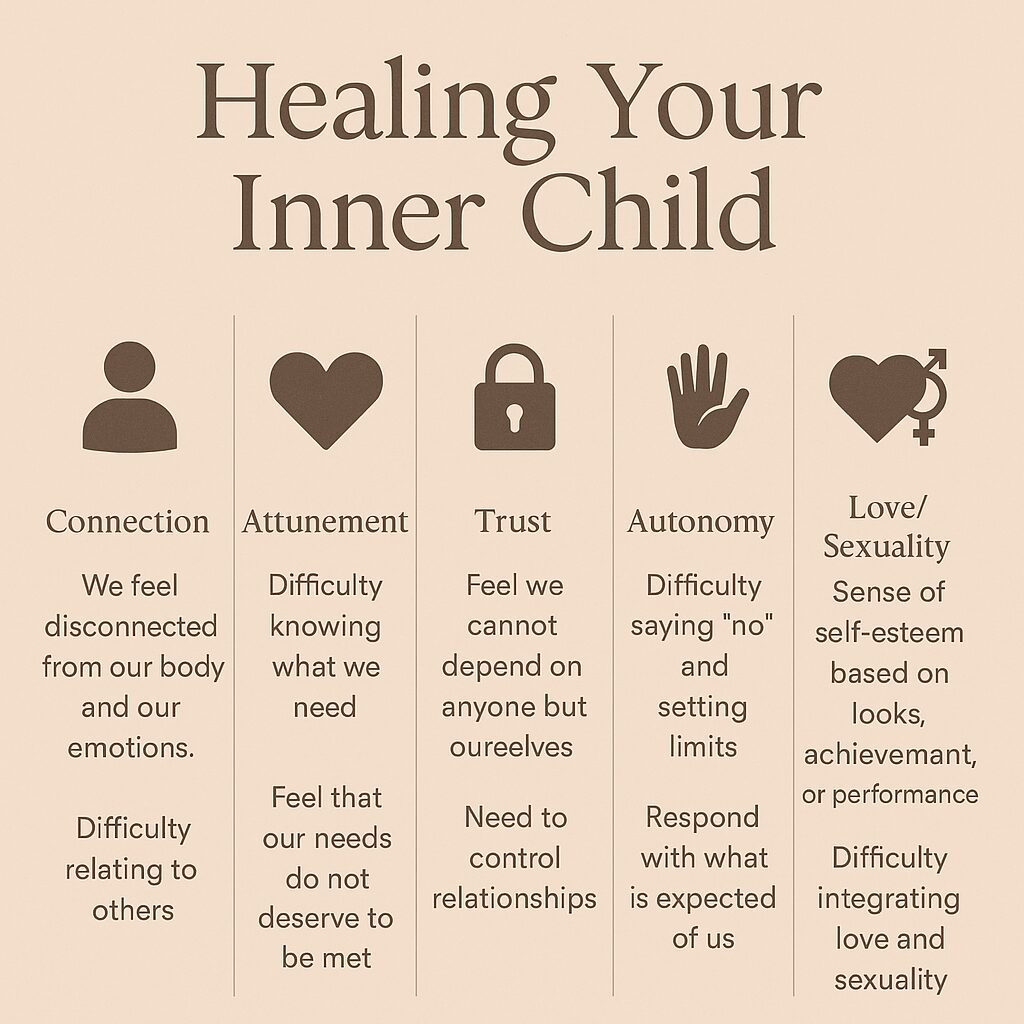One of the most powerful acts of self-love and growth is healing your inner child. Not only does this work benefit your own emotional well-being, but it also transforms the way you parent, love, and connect with others—especially your own children.
You may be surprised by how many of your day-to-day reactions stem from an inner child still carrying unhealed wounds.
A Familiar Scenario
Imagine this: you see a friend across the street. You smile and wave, but they keep walking without acknowledging you. You instantly feel hurt. Thoughts race—Did I do something wrong? Are they upset with me? You spend the rest of the week feeling anxious, wondering what you might have done.
It doesn’t even cross your mind that they simply didn’t see you.
In moments like these, it’s not your adult self reacting—it’s your inner child. The part of you that once felt unseen, dismissed, or guilty is reactivated. Instead of observing the moment objectively, you’re pulled into old emotional patterns.
A Personal Reflection
I work at a homeless shelter on Tuesdays, Wednesdays, and Saturdays. Tuesdays used to be the hardest—I am the senior member of only two staff on a Saturday. I’d feel physically sick with anxiety before going back after the short break from Saturday to Tuesday. – a busy staff-filled day. When I brought this up with my therapist, we traced the feeling back to childhood.
Growing up, I visited my dad every other weekend. Returning home, I never knew what kind of emotional atmosphere to expect—whether a fight had occurred or someone was in a volatile mood. The unpredictability left me in a constant state of anxiety.
That same feeling resurfaced decades later, every Tuesday morning. This was my inner child, still bracing for emotional impact. Once we had identified it, I started to heal. I realised I was reacting to the past, and that now – in the present, I am safe.
How Our Inner Child Shapes Our Reactions
When we’re operating from a wounded inner child, we often interpret present experiences through the lens of past hurt. The adult version of us might simply see a distracted friend walking by. But the inner child sees rejection.
The reason? As children, we’re wired for two essential needs: authenticity and attachment. When these needs clash, we sacrifice authenticity to maintain connection—because, for a child, disconnection from a caregiver feels life-threatening.
To survive, we internalise the belief that something must be wrong with me. This protective adaptation helps preserve the relationship, but it also becomes a subconscious pattern that follows us into adulthood—distorting how we see ourselves and others.
Recognising Your Survival Strategies
Healing begins with awareness. Many of our adult struggles—emotional dysregulation, low self-worth, and relationship difficulties—are rooted in these childhood survival strategies.
Here are five common survival styles, each named after a core developmental need:
1. Connection
Core need: To connect with self and others
As children, we may disconnect from our bodies and emotions to avoid pain. We grow up feeling numb, isolated, or invisible—often unable to form close, meaningful relationships.
2. Attunement
Core need: To express and receive care for our needs
We learn to suppress our needs to focus on others—especially caregivers. As adults, we struggle to identify or communicate what we need, and often believe our needs are unimportant.
3. Trust
Core need: To feel safe relying on others
If caregivers were unreliable, we learned to rely only on ourselves. Trust feels dangerous, so we become controlling or overly self-reliant, fearing vulnerability and dependence.
4. Autonomy
Core need: To express independence and set boundaries
We were taught that saying “no” was unsafe or shameful. As adults, we people-please, suppress our truth, and struggle with boundaries, often feeling burdened or resentful.
5. Love/Sexuality
Core need: To give and receive love with authenticity
We learned that love must be earned through performance, appearance, or achievement. We struggle to integrate heart and sexuality, and often equate our worth with what we do rather than who we are.
Which Survival Strategy Resonates With You?
Ask yourself:
-
Do I feel shame about simply existing or connecting? (Connection)
-
Do I struggle to identify and communicate my needs? (Attunement)
-
Do I fear vulnerability and dependence? (Trust)
-
Do I feel guilty setting boundaries or expressing my truth? (Autonomy)
-
Do I feel unworthy of love unless I “earn” it? (Love/Sexuality)
Recognising these patterns is the first step toward healing. When we meet our inner child with compassion, we begin to rewire the way we relate to ourselves and others. We reclaim our authenticity. We learn to trust. And we start living—not from old wounds—but from present wholeness.
Final Thoughts
Healing your inner child is not about blaming the past—it’s about understanding how the past shaped you, and choosing something better for the future.
You are not broken. You adapted. And now, as an adult, you have the power to choose new ways of being. The journey may not be easy, but the freedom and peace it brings is more than worth it—for you, and for the generations that follow.
Ready to Begin Your Healing Journey?
If any of this resonates with you, you don’t have to navigate it alone. Inner child work can be deeply transformative, and having the right support makes all the difference.
💬 Book a free consultation
Let’s explore how therapy can help you reconnect with your true self, heal old patterns, and move toward the life you deserve.
📩 Have questions first?
Feel free to get in touch — I’d love to hear from you.
You’re not too much. You’re not too sensitive. You’re someone whose story matters. And healing is possible.
Andrea x

